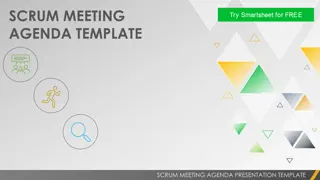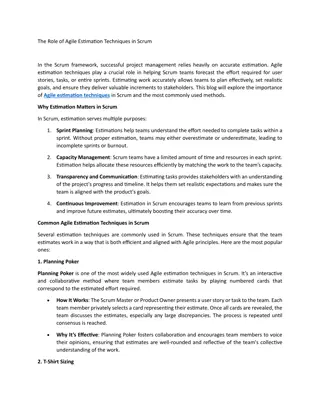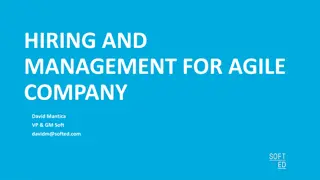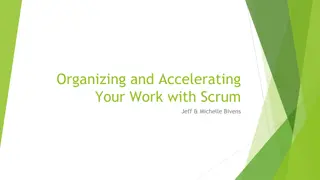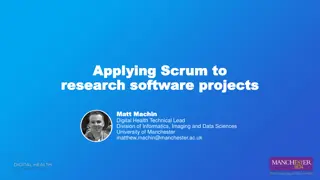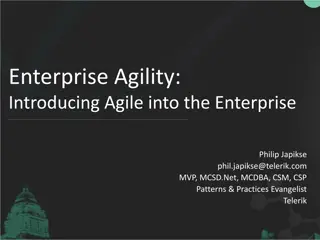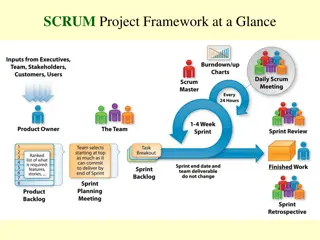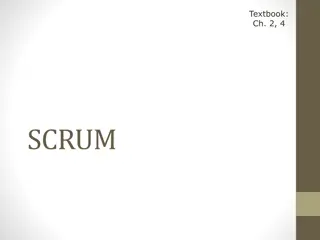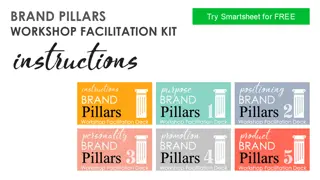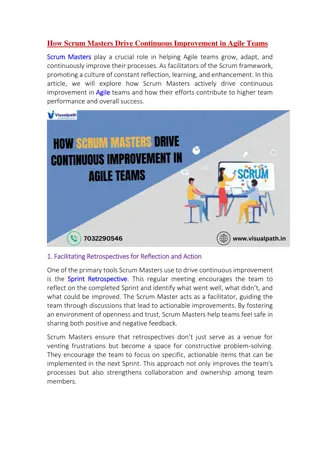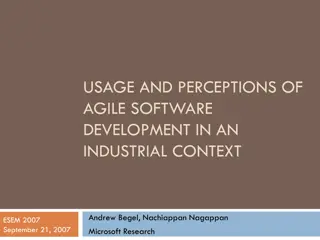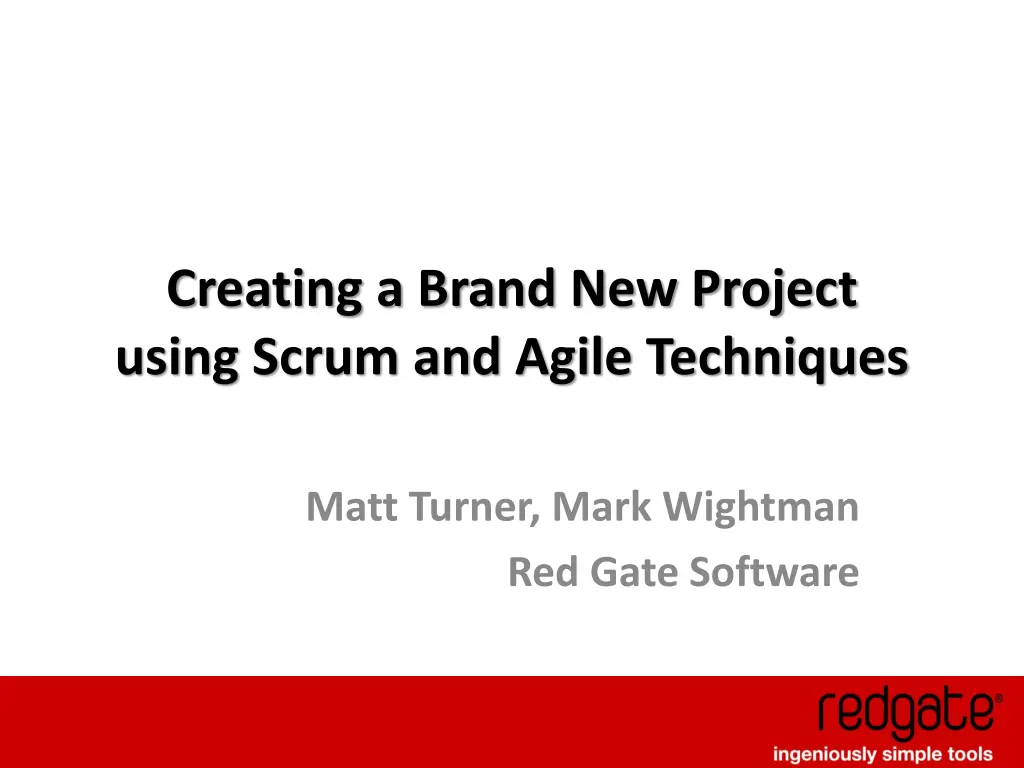
Brand New Project in Agile - A Scrum Approach
"Discover how to implement Scrum and Agile techniques in a new project for better product outcomes. Learn about incremental development, user feedback, guiding principles, and mechanisms for feedback to drive success efficiently and effectively."
Download Presentation

Please find below an Image/Link to download the presentation.
The content on the website is provided AS IS for your information and personal use only. It may not be sold, licensed, or shared on other websites without obtaining consent from the author. If you encounter any issues during the download, it is possible that the publisher has removed the file from their server.
You are allowed to download the files provided on this website for personal or commercial use, subject to the condition that they are used lawfully. All files are the property of their respective owners.
The content on the website is provided AS IS for your information and personal use only. It may not be sold, licensed, or shared on other websites without obtaining consent from the author.
E N D
Presentation Transcript
Creating a Brand New Project using Scrum and Agile Techniques Matt Turner, Mark Wightman Red Gate Software
Overview Background Incremental Development + User Feedback = Better Product! If you want to release quicker, Automate Focus on your backlog Good estimation means better decisions
Guiding Principles Ingeniously simple, world class designs Minimal set of valuable functionality available as soon as possible Be able to do public releases within one week of sprint end Minimise technical debt Automate as much as possible
Incremental Development + User Feedback = Better Product!
User Feedback is Critical Previous Red Gate experience Don t trust your assumptions about what customers need and want Recreating realistic environments for testing is hard Intensive Early Access (EA) Program Early and regular feedback Increased confidence in stability
Prototype Usability Tests Dec 2008 v1 Release 30 Jun Usability Test 13 Nov Sprint 1 21 Aug Start Prep Mar 2009 2009 2010 Q1 Jan Q2 Apr Q3 Jul Q4 Oct Q1 Jan Q2 Apr Feb Mar May Jun Aug Sept Nov Dec Feb Mar May Jun Technical Investigations Initial UI Design Backlog Preparation June August 6 EA Releases 2 Beta Releases 1 Release Candidate (average every 3 weeks)
Mechanisms for User Feedback Usability Tests UserVoice SmartAssembly Product Support Team/Forum
Incremental Development Feedback is most valuable if users have working software they can actually use Incremental development Build product feature by feature Vertical slices Each feature tested as it is built
Advantages of Small Stories 1. Easy to implement subset of functionality 2. Easy to change priorities 3. Easier to define and estimate stories 4. Focus better during development 5. Easier to sync testing with development (in theory)
Add database stories Story Points Sprint Add database to Subversion (very basic URL input) 3 2 Automatically include missing trailing / (Added) 1 8 Authenticate Subversion user 3 9 Support https connections to Subversion 2 10 Add database to TFS (very basic URL input) 8 13 Auto-detect TFS/SVN 3 14 Remember Recent Source Control System URLs 1 14 21 Select location by browsing SVN repository 5 Not needed Select location by browsing TFS repository 5 Not needed Add database to local evaluation repository 5 Not needed 15
Sprint 2 >> Add database to Subversion (very basic URL input) Automatically include missing trailing / (Usability) Authenticate Subversion user Support https connections to Subversion Add database to TFS (very basic URL input) Auto-detect TFS/SVN Remember Recent Source Control System URLs
Sprint 8 Add database to Subversion (very basic URL input) >> Automatically include missing trailing / (Usability) Authenticate Subversion user Support https connections to Subversion Add database to TFS (very basic URL input) Auto-detect TFS/SVN Remember Recent Source Control System URLs
Sprint 10 Add database to Subversion (very basic URL input) Automatically include missing trailing / (Usability) >> Authenticate Subversion user >> Support https connections to Subversion Add database to TFS (very basic URL input) Auto-detect TFS/SVN Remember Recent Source Control System URLs
Sprint 13 Add database to Subversion (very basic URL input) Automatically include missing trailing / (Usability) Authenticate Subversion user Support https connections to Subversion >> Add database to TFS (very basic URL input) Auto-detect TFS/SVN Remember Recent Source Control System URLs
Sprint 14 Add database to Subversion (very basic URL input) Automatically include missing trailing / (Usability) Authenticate Subversion user Support https connections to Subversion Add database to TFS (very basic URL input) Auto-detect TFS/SVN Remember Recent Source Control System URLs
Did we do the right thing? Only 26 out of >1000 licensed users have requested more Could have spent x2 effort Delayed release (at least 1 more sprint) It s all the little things that add-up!
If you want frequent releases: Automate Focus on your Backlog
Our Testing Challenge 175 distinct environments If we hadn t automated: Several weeks of regression tests per release Difficult to justify frequent releases High cost for additional environments
Our Solution Continuous Integration Unit tests Integration engine tests Nightly Automated GUI acceptance/regression tests in a virtual lab Manual exploratory testing (per story) Manual regression testing (per release)
Automated GUI Tests VMLogix Labmanager 1 Launch Virtual Machines Virtual Machines 2 Initiate VM Automation App - Install Test Runner - Install Nunit - Install Ranorex Gui Framework - Install Product - Copy test assemblies CRUISECONTROL VM Automation Application 3 Start running tests using Pnunit (Distributed Nunit) Return Nunit Results 4 Return results - Nunit results - Screenshots - Product logs
Results Advantages Much less manual testing for each release More confidence in builds Simple to test additional environments Disadvantages A lot of effort to build infrastructure Hard to make them reliable Can be time-consuming to build new tests
The Product Backlog Incremental approach needed small, well- written stories Well-formed backlog early in project Continuous backlog grooming and reprioritisation
Up Front Preparation Advantages Well-refined product backlog Better estimate of overall size of project Disadvantages Lots of meetings Team started to get bored Not very agile
Can you release it sooner? Competitor launch set for June 2010 We had to be in the market! But we knew this wasn t likely
How we knew we had a problem January 2011
Reducing the backlog size Dropped some features entirely until v1.1 Limited scope for this Split stories The 80/20 rule Applied very strict prioritisation Challenged team to cut stories Is it more important than ? New team members challenged assumptions
Good Estimation Means Better Decisions
What We Did Before sprint 1: Estimated (most of) backlog Estimated velocity range Derived earliest/latest dates for release Backed up by gut feel After a few sprints: Updated predictions using observed velocity data
Spikes Used spikes frequently: To de-risk When we couldn t estimate Team started to insist on this if they couldn't estimate
It Worked! Team s initial velocity estimates: Worst case = 19 Most likely = 23 Best case = 34 Derived project lengths backed up by gut feel Actual mean velocity over project = 22
Good Estimation Helps Team tried hard to estimate stories carefully Stephanie and David used numbers to evaluate options Felt like we had good understanding of status throughout Backed up by gut feel Better decision making
Conclusions Incremental development and Early Access releases helped us to build the right product Test automation was critical Focusing on the backlog helped us to build it quicker Effective estimation and planning helped us to make good decisions




